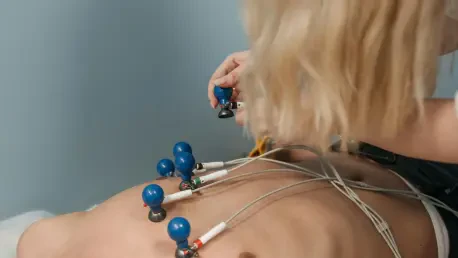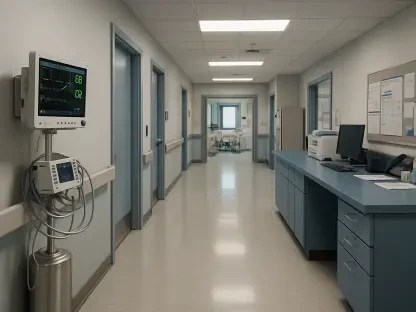The interventional cardiology devices market is experiencing a remarkable rise, driven by the pressing demand for minimally invasive solutions to tackle cardiovascular diseases, which continue to be a primary cause of mortality worldwide. Currently valued at $8.43 billion, this market is projected to soar to an impressive $11.48 billion by 2034, with a compound annual growth rate (CAGR) of 3.37%. These devices, including stents, catheters, and angioplasty balloons, are transforming healthcare by offering safer alternatives to traditional open-heart surgery, thereby cutting down recovery times and associated risks. This growth path underscores their vital role in managing heart conditions through innovative, catheter-based methods.
Beyond the figures, the increasing prevalence of cardiovascular conditions serves as a grim reminder of the ongoing global health crisis. Factors like aging populations, sedentary lifestyles, and limited access to healthcare in some regions are heightening the need for early diagnosis and effective treatments. Consequently, the adoption of advanced interventional tools is accelerating, enabling cardiologists to address complex issues like coronary artery disease with enhanced precision. This shift not only boosts patient outcomes but also reduces the financial strain on healthcare systems by shortening hospital stays and long-term care requirements. Despite the potential, challenges such as workforce shortages and regulatory hurdles pose significant threats to progress in this critical field.
Market Growth and Drivers
Rising Prevalence of Cardiovascular Diseases
The global burden of cardiovascular diseases continues to grow, putting immense pressure on healthcare systems worldwide and fueling the demand for interventional cardiology devices. Heart conditions, including coronary artery disease and arrhythmias, are worsened by demographic changes such as aging populations, especially in developed countries with higher life expectancy. In low- and middle-income nations, limited access to quality care exacerbates the problem, often leading to late-stage diagnoses that require urgent intervention. Lifestyle factors, such as poor diet, lack of exercise, and increasing obesity rates, further contribute to the rising incidence of these diseases. This alarming trend highlights the urgent need for devices that enable early and effective treatment, positioning the market for consistent growth as healthcare providers work to tackle this widespread health challenge.
Beyond the immediate health impacts, the socioeconomic consequences of cardiovascular diseases are significant, particularly in regions with limited resources. The cost of untreated conditions often results in lost productivity and greater reliance on public health systems, creating a cycle of economic burden. Interventional devices provide a solution by enabling quicker, less invasive procedures that reduce hospital stays and help patients return to normal life sooner. Public health campaigns also play a key role by increasing awareness of risk factors and the importance of regular check-ups, thereby driving demand for diagnostic and therapeutic tools. As more individuals seek preventive care, the market for these life-saving devices is expected to experience sustained growth over the coming years.
Technological Innovations
Technological advancements are at the forefront of revolutionizing the interventional cardiology devices market, greatly improving the safety and effectiveness of procedures. Innovations like drug-eluting stents, which release medication to prevent artery re-narrowing, and bioresorbable scaffolds that dissolve over time, are setting new treatment standards. Additionally, robotic-assisted catheterization systems are enhancing precision, allowing cardiologists to perform complex interventions with greater accuracy. These developments are especially beneficial for high-risk patients who may not be suitable for traditional surgery, broadening the range of treatable conditions. The ongoing evolution of these technologies demonstrates the industry’s dedication to meeting unmet clinical needs through state-of-the-art solutions.
Equally important is the significant investment in research and development (R&D) by leading companies to maintain a competitive edge in this dynamic market. The focus on next-generation tools, such as advanced imaging systems integrated with interventional platforms, is streamlining workflows in catheterization labs and enhancing diagnostic capabilities. These efforts not only improve patient outcomes but also reduce long-term complications like restenosis, a frequent issue with earlier stent designs. As manufacturers push the boundaries of innovation, collaboration with tech firms and healthcare providers is becoming more common, creating an ecosystem where new ideas can be quickly tested and implemented. This relentless drive for progress is a major factor behind the market’s projected growth trajectory through 2034.
Regional Insights and Variations
North American Dominance
North America stands as the leading force in the interventional cardiology devices market, largely due to its advanced healthcare infrastructure and high prevalence of cardiovascular diseases. The United States, in particular, holds a substantial share, driven by significant healthcare spending and access to cutting-edge medical technologies. The region benefits from a well-established network of hospitals and specialized cardiac centers equipped with modern catheterization labs. Additionally, the high incidence of heart-related conditions, fueled by lifestyle factors like obesity and stress, maintains a strong demand for devices such as stents and catheters. This dominance is further supported by the presence of major industry players based in the region, who drive innovation and set global standards.
Another factor strengthening North America’s position is the strong focus on early diagnosis and preventive care, supported by widespread health insurance coverage and public health initiatives. Patients in this region often have access to regular screenings, leading to earlier detection of cardiovascular issues and, consequently, greater use of interventional procedures. Regulatory bodies, though strict, provide a clear framework for device approval, enabling faster market entry for new technologies compared to less structured regions. Despite these advantages, challenges like rising healthcare costs and disparities in access between urban and rural areas persist, potentially affecting the uniform distribution of advanced care. Nevertheless, North America remains a cornerstone of market growth.
Asia-Pacific Growth Potential
The Asia-Pacific region is emerging as the fastest-growing market for interventional cardiology devices, driven by rapid urbanization and a rising burden of cardiovascular diseases. Countries like China and India are seeing a concerning increase in heart conditions due to changing lifestyles, including sedentary habits and dietary shifts toward processed foods. At the same time, improvements in healthcare infrastructure, supported by government investments and private sector involvement, are making advanced treatments more accessible. This region’s large and growing population further increases the demand for cost-effective, minimally invasive solutions, positioning it as a critical area for market expansion over the next decade.
Government initiatives in Asia-Pacific are also playing a vital role in driving market growth by improving access to cardiac care through policy reforms and expanded insurance coverage. Programs aimed at increasing the number of trained cardiologists and establishing more catheterization labs are addressing critical gaps in healthcare delivery. Additionally, rising disposable incomes in urban centers are enabling more patients to afford sophisticated treatments that were previously out of reach. However, challenges such as uneven healthcare distribution, particularly in rural areas, and varying regulatory standards across countries can hinder progress. Despite these obstacles, the region’s potential remains unmatched, with manufacturers increasingly focusing on tailored solutions to meet local needs.
Europe’s Established Market
Europe holds a significant position in the interventional cardiology devices market, supported by its well-developed healthcare systems and a growing elderly population prone to heart conditions. Nations like Germany, France, and the United Kingdom are at the forefront, benefiting from universal healthcare models that ensure broad access to advanced medical interventions. The region’s high prevalence of cardiovascular diseases, combined with a strong emphasis on preventive care, drives consistent demand for devices used in minimally invasive procedures. Furthermore, the presence of numerous specialized facilities, including an increasing number of catheterization labs, supports the widespread adoption of these technologies across both urban and suburban areas.
Innovation and collaboration are also key strengths of the European market, with many countries hosting research hubs that contribute to the development of next-generation interventional tools. Partnerships between device manufacturers and academic institutions are fostering advancements in areas like bioresorbable stents and AI-driven diagnostics, ensuring that Europe remains a leader in adopting cutting-edge solutions. However, an aging demographic poses a dual challenge, increasing disease incidence while straining healthcare budgets and workforce capacity. Regulatory harmonization under frameworks like the European Union’s Medical Device Regulation adds another layer of complexity for market entrants. Still, Europe’s established infrastructure and commitment to quality care solidify its role as a vital market segment.
Challenges and Opportunities
Barriers to Market Expansion
The interventional cardiology devices market faces several significant barriers that could impede its growth trajectory, with workforce shortages standing out as a critical issue. In many regions, especially rural and developing areas, there is a lack of trained interventional cardiologists capable of performing complex catheter-based procedures. This shortage limits access to life-saving treatments and slows the adoption of advanced devices. Additionally, the rapid evolution of technology requires continuous education and training for healthcare professionals, which can be both time-consuming and costly. Addressing this gap demands targeted investments in medical education and telemedicine solutions to extend expertise to underserved locations.
Another pressing challenge lies in the stringent regulatory requirements that govern the approval and market entry of new devices. Compliance with these standards often involves lengthy and expensive processes, delaying the availability of innovative tools to patients who need them most. Supply chain disruptions, as seen during global crises, further complicate the situation by affecting the timely production and distribution of critical components. The risk of device recalls due to safety concerns also looms large, adding to manufacturer costs and eroding consumer trust. Overcoming these hurdles will require streamlined regulatory pathways, robust supply chain strategies, and enhanced collaboration between industry stakeholders and policymakers to ensure that growth is not stifled.
Emerging Opportunities
Despite the challenges, the interventional cardiology devices market is ripe with opportunities, particularly with the growing preference for minimally invasive procedures over traditional open-heart surgeries. Patients and healthcare providers alike favor these techniques for their reduced recovery times, lower risk profiles, and cost-effectiveness, creating a sustained demand for advanced tools like stents and catheters. This shift is supported by technological breakthroughs such as AI-enabled imaging systems that enhance diagnostic accuracy and procedural outcomes. As these innovations become more accessible, they open new avenues for treating a broader patient demographic, including those previously deemed unsuitable for intervention.
Significant growth prospects also exist in emerging markets, where investments in healthcare infrastructure are on the rise, particularly in regions like Asia-Pacific and Latin America. Government reforms aimed at improving access to quality care, coupled with expanding insurance coverage, are driving the adoption of interventional devices in these areas. Manufacturers have a unique chance to tailor products to local needs, offering affordable yet effective solutions that can penetrate price-sensitive markets. Furthermore, the integration of digital health technologies, such as remote monitoring and telemedicine, presents an opportunity to improve post-procedure care and patient follow-up. Capitalizing on these trends could position the market for exponential growth while addressing global disparities in cardiovascular care.
Impact of External Factors
COVID-19 Disruptions
The COVID-19 pandemic delivered a substantial blow to the interventional cardiology devices market, causing a notable decline in demand during its peak. Hospitals worldwide were forced to postpone elective procedures, including critical interventions like angioplasty, to prioritize pandemic-related care and minimize infection risks for patients and staff. This deferral led to a sharp drop in procedural volumes, directly impacting the utilization of devices such as stents and catheters. The ripple effect was felt across the industry, as manufacturers faced reduced orders and healthcare providers grappled with reallocating resources to manage the unprecedented health crisis, highlighting the market’s vulnerability to external shocks.
Supply chain disruptions compounded the challenges during this period, with global lockdowns and travel restrictions delaying the availability of essential components for device production. Clinical trials for new technologies were halted or slowed, pushing back product launches and innovation timelines. Training programs for healthcare professionals, often conducted in-person to ensure hands-on experience with advanced tools, were similarly affected, limiting the adoption of cutting-edge systems. The financial strain on hospitals, many of which faced budget cuts due to decreased elective procedure revenue, further restricted investments in new equipment. These multifaceted disruptions underscored the need for more resilient systems to safeguard the market against future crises.
Post-Pandemic Recovery
Following the initial setbacks caused by the pandemic, the interventional cardiology devices market has shown a strong recovery, with procedural volumes rebounding to pre-crisis levels. Pent-up demand for deferred treatments has fueled a surge in interventions, as patients who delayed care during the height of the pandemic now seek urgent attention for cardiovascular conditions. This resurgence reflects a renewed emphasis on heart health across healthcare systems, with providers prioritizing the backlog of cases to prevent worsening outcomes. The recovery phase has also seen a notable uptick in the CAGR, signaling robust market confidence and a return to steady growth patterns through the forecast period.
The pandemic’s lasting impact has prompted the industry to adopt innovative solutions to enhance resilience, such as digital tools for remote training and telemedicine platforms for patient consultations. These adaptations have proven invaluable in maintaining continuity of care and ensuring that healthcare professionals can stay updated on new technologies without the need for in-person sessions. Additionally, the focus on building more robust supply chains has gained traction, with companies diversifying sourcing strategies to mitigate risks of future disruptions. This recovery trajectory not only demonstrates the market’s adaptability but also sets the stage for sustained advancements in addressing global cardiovascular health challenges.
Future Pathways for Market Evolution
As the interventional cardiology devices market reflects on its journey, the path forward becomes clearer with a focus on actionable strategies to sustain momentum. Overcoming persistent challenges like workforce shortages requires investment in medical training programs and leveraging digital platforms to extend expertise to remote areas. Streamlining regulatory processes to accelerate the approval of innovative devices emerges as a priority, ensuring patients can access cutting-edge treatments without unnecessary delays. The lessons from past disruptions, particularly around supply chain vulnerabilities, underscore the importance of building resilient systems capable of withstanding global crises.
Looking ahead, fostering collaboration between manufacturers, healthcare providers, and policymakers offers a promising avenue to address regional disparities and improve access to care. Emphasizing public health initiatives to promote early diagnosis remains crucial, as does tailoring affordable solutions for emerging markets with growing healthcare needs. The integration of advanced technologies, from AI-driven diagnostics to robotic systems, holds the potential to further revolutionize patient outcomes. By prioritizing these steps, the market can continue to transform cardiovascular care, ensuring that innovations reach those most in need and ultimately reducing the global burden of heart disease.









